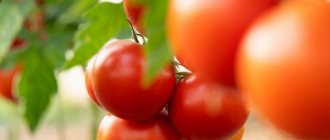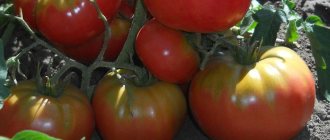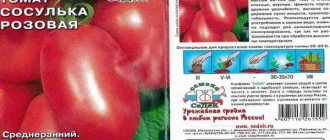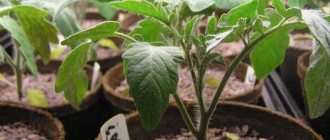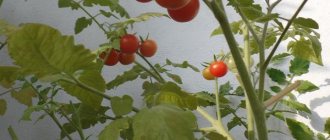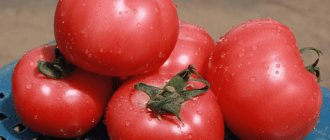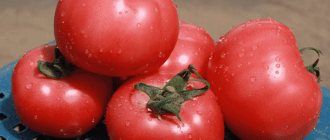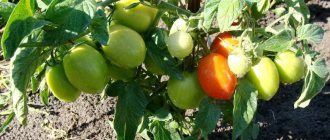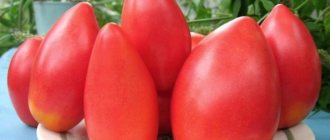Tomato Orlets - description and characteristics of the variety
General characteristics
A description of the characteristics of the hybrid will help you develop the culture.
- The discharge is indeterminate.
- Plants are 150–170 cm high.
- There are from 6 to 8 fruits on one brush.
- Ripening lasts from 75 to 80 days.
- The tsedrate has a round shape.
- The average fruit weight is from 100 to 150 grams.
- The fruits have a high density.
- Vegetables are fast-growing and transportable.
(language correctly to grow a crop on the plot
If you use a seedling recipe, you can get a fairly early harvest. The timing of sowing needs to be considered on an individual basis. It is necessary to count exactly 2 months (60 days) from the moment of the first shoots, and only after that transplant the seedlings into the ground. Depending on regional climatic conditions, each summer resident needs to calculate the timing himself.
You can plant seedlings early enough, in compliance with all the necessary rules and requirements. The color of the crop depends on the resistance of the plants:
It is necessary to regulate watering. If (soon) the soil becomes waterlogged, this can lead to rotting of the roots. If there is not enough moisture, this will also not have the best effect on the tomatoes. In order for the sprouts to be persistent and not stretched, they need good lighting. In order for the root system to develop to its full potential, the plant needs (reinforced with minerals, which will stimulate growth. It is necessary to dive in the second phase of a true leaf
It is also important to take care to distribute the plants into separate containers, with the intention of creating space for them.
To facilitate the appearance of additional roots, it is necessary to shorten the roots if they die and do not rise during the dive. This will help the plant develop a more powerful root system. 2 weeks before planting seedlings in grounding, you need to take them outside. This is necessary so that the plants get used to the wind and sunlight. On the first day you need to splash out for 15–20 minutes, every day the time can be increased.
Sooner or later the night frosts will end, you can move the plants to a permanent location. On one square meter you need to place from 3 to 4 bushes; pinching is not required. Organic fertilizers and minerals should be used as fertilizing. Quite often, plants are fed with complex fertilizers, which consist of several components.
Humidification should be done in the evening using warm water. In order for the soil to retain moisture for a long time, it is necessary to carry out the procedure of mulching the beds. In turn, do not forget about loosening and hilling.
Immunity to diseases
Often hybrids have an inflexible immunity to a number of diseases. The Orlets F1 variety is not susceptible to diseases such as late blight, white spot and tobacco mosaic.
You should not forget about preventive work (avoiding the protection of tomatoes from insects. Before flowering, you need to use chemicals, and after flowering - folk remedies.
Productivity of the variety and application in everyday life
If you meet the necessary requirements, then from 1 m2 of land you can accumulate from 5 to 6 kilograms of tomatoes. Tomatoes of this variety can be used both for canning and for fresh consumption.
Positive and negative sides
The Orlets F1 lens has more advantages than disadvantages. This is explained by the fact that tomatoes are a hybrid.
- High yield.
- Unbreakable immunity.
- Keeping quality.
- Transportability.
- The bushes do not need pinching.
Poverty:
seeds are not capable of storing the genes of their parents.
The early-ripening variety “Orlets” is grown so that you can enjoy tomatoes already in the summer.
Do summer residents say anything about the Orlets variety?
Both for inexperienced gardeners and for specialists, before planting a new variety it will be useful to get to the heart of the matter with reviews. After studying them, you can already make the final selection.
- Sergei Ivanovich, 30 years old:
He has been growing tomatoes for quite a long time. I like the amphidiploid “Eagle” because the plants produce an impeccable harvest. The fruits ripen very quickly. Expressive taste, the seeds are not noticeable. Appreciates the durability of tomatoes. Under optimal conditions, it was possible to heap up to 40 kg of fruit. Recommends growing this variety for those who are interested in selling vegetables. - Elena, 55 years old:
Very good for winter preparations, as well as for fresh salads. Productivity is high even when grown in unfavorable conditions. No special care required. - Marisya P., 38 years old:
The tomatoes have time to ripen on the bushes. The characteristics are excellent, the only drawback is that it is impossible to collect the seeds.
Tomato Neptune F1 early tomato seeds (Elite series)
Tomato Neptune is a white-fruited early hybrid.
Fruit ripening occurs on hundredths of days after germination.
The inflorescence of this hybrid is simple, with 5 or 6 fruits.
The first inflorescence is formed above the 5th or 6th leaf.
The fruits have a round shape, and each of them weighs about 140 grams.
Resistant to Alternaria and TMV.
Tomato seeds Neptune F1 (Elite range) can be in two types of packaging:
- original packaging (from the manufacturer)
- Seed Supermarket packaging.
If you only need seeds in original packaging, please indicate this in the comments to your order or tell the sales consultant this when placing your order by phone.
The manufacturer reserves the right to change the packaging design, color and availability of seed treatment.
If this item does not have a package with a suitable number of seeds, please inform our sales manager - he will try to help you open the package or offer a suitable analogue.
Very often, customers call our online store and ask for advice before purchasing tomato seeds. Our sales consultants are always ready to help any buyer, regardless of whether he wants to buy tomato seeds wholesale or retail.
Below we want to give you a couple of tips when choosing tomato varieties. We hope that our tips will help you in your future purchases.
Indeterminate or determinate tomato?
First of all, we pay attention to the specifics of the development of the above-ground part of the plant, that is, to the size of the future bush.
According to the type of bush, they are divided into: indeterminate varieties of tomatoes or tall (with unlimited stem growth, powerful shoots and branching, more often found in mid- and late-ripening tomatoes), and determinate varieties of tomatoes or low-growing (with weakly branching bushes, with shoots only in the lower part of the stem , growth stops after the appearance of 3-4 inflorescences, grown mainly in open ground).
Semi-determinate and super-determinate varieties of tomatoes are intermediate types that stop growing unexpectedly, making it practically impossible to predict the size of the future bush.
Large-fruited tomato seeds
If your goal is to obtain large fruits, preference should be given to representatives of the indeterminate group. Although caring for such tomatoes is more troublesome (constant tying, pinching, removing lower leaves, etc.), they bear fruit much longer than low-growing ones, yielding the harvest in “portions,” which makes it possible to get real large fruits.
If you are determined to get a quick and abundant harvest, albeit with smaller fruits, choose determinate varieties. Caring for them is quite simple, and they produce a rich and friendly harvest (which is important for obtaining early, expensive products).
Consider the region
When choosing tomato seeds, it is also important to adapt them to your growing region. It is necessary to take into account regionalization, especially in the southern regions, giving preference to varieties and hybrids of tomatoes that are resistant to heat, aridity, sudden temperature changes, and have a high degree of immunity to diseases and pests.
Tomato ripening time
Depending on the target direction of the future harvest (preservation, processing, fresh consumption, obtaining market profit), it is necessary to determine which group of tomatoes according to ripening time to choose: early-ripening varieties (the period from germination to fruit ripening is 90-110 days), mid-ripening varieties tomatoes (from germination to harvest 110-130 days), late-ripening tomatoes (period from germination to harvest 130 days or more).
Red, pink or yellow tomato?
In addition to the above criteria for selecting the seeds of tomato varieties and hybrids that are suitable for you, ask the seller what fruits you are expected to get acquainted with - red tomato seeds produce dense, even fruits with an average weight. They tolerate transportation well and have a high degree of shelf life, so they are ideal for sales.
Thin-skinned, sugary, juicy fruits, most often pink, orange or yellow in color.
It is better to choose raspberry tomato seeds to obtain a harvest for your own consumption (they are sometimes called salad tomatoes).
In addition, manufacturing companies offer varieties and hybrids intended purely for canning, drying, drying, freezing, preparing sauces, ketchups, etc.
Growing: in open or closed ground?
The next selection criterion is determining the method of cultivation, indoors or outdoors. Actually, everything is simple here - every manufacturing company that values its reputation must indicate in the instructions what type of soil a particular variety (hybrid) is suitable for.
But there are also those that are suitable for growing both in open and closed ground. In this case, the decision is yours, but we advise you to take into account that although indeterminate tomatoes are demanding to care for, their yield, due to prolonged flowering and the formation of ovaries, is much higher than that of determinates.
The advantages of determinate tomatoes are an early, almost simultaneous harvest, plus practicality - if 2-3 pieces fit on one square meter of indeterminate tomatoes, then 4-5 determinants, which is important for small greenhouses, besides, their early return makes it possible to quickly prepare for the second crop rotation.
Hybrids and varieties of tomatoes
Are you faced with a choice – variety or hybrid? Varietal seeds are usually cheaper than hybrid seeds, and they are more common, but if farming in your region is complicated by abnormal climatic conditions or frequent attacks by viruses, fungi, and pests, choose hybrids. When working to remove them, the main emphasis is on strong immunity and high adaptive ability.
And lastly, don’t imagine monsters when you hear the word “hybrid F”; be aware that GMOs and F1 are not the same thing. The abbreviation “GMO” hides genetic modifications, and “F” is simply the initial letter of the Italian word Filli, that is, “children” - this is the name for the new generation of old varieties obtained by combining their carrier genomes.
If you have any questions, we will be happy to help you and hope that you will place your order on our website. We offer you a large selection of quality seeds from manufacturers. In our online store you can buy tomato seeds by mail with delivery throughout Ukraine.
Page 3
13 Variety: Hybrid Ripening period: Mid-late Type: White Fruit type: 2.5-4 kg head Shape: Round
- 12
Variety: HybridRipening period: EarlyType: Supersweet
- 10
Variety: Variety Ripening period: Mid-ripening Fruit type: Crimson Sweet type Shape: Oval
- 10
Variety: HybridRipening period: EarlyType: SweetFruit type: Hungarian type (conical)
- 10
Variety: HybridRipening period: EarlyType: ParthenocarpicFruit type: short-fruited up to 14cm
- 9
Variety: HybridRipening period: EarlyType: Supersweet
- 8
Variety: HybridRipening period: Ultra earlyType: ParthenocarpicFruit type: short-fruited up to 14cm
- 8
Variety: HybridRipening period: Ultra earlyType: ParthenocarpicFruit type: short-fruited up to 14cm
- 7
Variety: HybridRipening period: Mid-earlyFruit type: Pineapple typeShape: Oval
- 7
Variety: Hybrid Ripening period: Mid-season Type: Beijing Shape: Cylindrical
- 6
Variety: HybridRipening period: EarlyType: Bee-pollinatedFruit type: short-fruited up to 14cm
- 6
Variety: HybridRipening period: EarlyType: SweetFruit type: Block type (short-cuboid)
- 6
Variety: HybridRipening period: EarlyType: ParthenocarpicFruit type: short-fruited up to 14cm
- 5
Variety: HybridRipening period: Ultra earlyType: ZucchiniShape: Cylindrical
- 5
Variety: HybridRipening period: Ultra earlyForm: Oval-cylindrical
- 5
Variety: HybridRipening period: Ultra earlyType: ParthenocarpicFruit type: short-fruited up to 14cm
- 5
Variety: Variety Ripening period: Mid-season Shape: Oval-cylindrical
- 5
Variety: VarietyRipening period: EarlyPlant type: Sora typeShape: Round
- 5
Variety: HybridRipening period: EarlyType: ParthenocarpicFruit type: short-fruited up to 14cm
- 4
Variety: HybridRipening period: Mid-ripeningFruit type: Crimson Sweet typeShape: Oval
- 4
Variety: Variety Ripening period: Medium-late Fruit type: Crimson Sweet type Shape: Round
- 4
Variety: HybridRipening period: Ultra earlyForm: Cylindrical
- 4
Variety: Hybrid Ripening period: Ultra-early Fruit type: large-fruited tomatoes (180-250 g) Plant type: DeterminateShape: Round-flattened
- 4
Variety: HybridRipening period: EarlyShape: Elongated-cylindrical
- 4
Variety: VarietyRipening period: Mid-ripeningFruit type: Charleston Gray typeShape: Elongated
- 4
Variety: HybridRipening period: Ultra earlyType: ParthenocarpicFruit type: short-fruited up to 14cm
- 4
Variety: HybridRipening period: EarlyFruit type: medium-fruited tomatoes (100-180 g)Plant type: IndeterminateShape: Round-flattened
- 4
Variety: HybridRipening period: Ultra earlyType: OnionPlant type: OMY
Shape: Round
- 4
Variety: HybridRipening period: EarlyFruit type: Crimson Sweet typeShape: Round
- 4
Variety: Hybrid Ripening period: Early Fruit type: large-fruited tomatoes (180-250 g) Plant type: Indeterminate
Shape: Round
- 4
Variety: HybridRipening period: Ultra earlyFruit type: Pineapple typeShape: Oval
- 4
Variety: HybridRipening period: Ultra earlyType: White Fruit type: up to 1.5 kg headShape: Round
- 4
Variety: Hybrid Ripening period: Mid-early Type: Sweet Fruit type: Block type (short-cuboid)
- 4
Variety: VarietyPlant type: Mustard
- 3
Variety: HybridRipening period: Medium-late Fruit type: Crimson Sweet typeForm: Elongated
- 3
Variety: HybridRipening period: EarlyType: ParthenocarpicFruit type: short-fruited up to 14cm
Subscribe to news Connect with us on social networks
Source: https://semena.cc/ru/3590-neptun-f1-semena-tomata-det-elitnyi-riad.html
Agrotechnics of cultivation
Sowing seeds can begin in the third decade of February - early March. It depends on the region. Seeds can be planted immediately to avoid the picking stage. To do this, you can use peat pots right away or sow seeds in one container, but 6 cm apart from each other to a depth of about 1 cm.
After sowing, containers or pots, which are easier to put in one container, are covered with film. But first, the seeds are moistened from a spray bottle with warm water without lime.
Yes, before planting, the seed material can be pickled in a solution of potassium permanganate, then dried and a growth stimulant applied. This is done about a couple of weeks before the intended planting.
When the seedlings appear, in the first days they only need watering. Again, use a spray bottle and settled water so as not to wash away the fragile sprouts. Two weeks after the first shoots, the seedlings are watered with complex fertilizer for tomatoes. Feeding is repeated after another 2-3 weeks, if up to this point the seedlings have not yet been transferred to open ground or a greenhouse. And this happens in May or June, depending on the region.
Conditions for growing seedlings:
- room temperature is at least 23-25 degrees;
- good humidity;
- good lighting;
- additional illumination in cloudy weather.
During transfer to open ground or a greenhouse, the soil is dug up in advance, leveled, and a spoonful of complex fertilizer is added. During the season you will need to feed the crop 3-4 more times. You can use chemical fertilizers, or organic matter in the form of urea, manure, litter. 4 bushes are planted per square meter. In the first days after planting, it is better to protect the seedlings from the wind and night coolness.
There is no need to form bushes, and there is no need to tie up or remove stepchildren. It is necessary to monitor pests and ensure that the bushes are evenly moistened in dry weather. If signs of disease begin, the bushes must be treated with medications. But you cannot use chemicals when the fruits have already formed. There are many biological and environmentally friendly products available for pest and disease control.
We hope that this variety is of interest to you, because its advantages outweigh one single disadvantage. All characteristics make it clear that “Shuttle” is a worthy variety.
Growing tomatoes
Like all hybrids, Ilyich F1 tomatoes are grown primarily by seedlings.
How to prepare seeds?
Store-bought seeds should be soaked briefly in growth stimulants. This procedure will significantly increase the germination of planting material.
Sowing seed material
To plant seeds, you need to prepare light and nutritious soil. The soil usually consists of garden soil and humus, with the addition of a small amount of washed river sand.
The seeds are planted in a container with soil to a depth of no more than 2 cm. The plantings are sprinkled with peat on top and sprinkled with warm soft water. IMPORTANT: To germinate, seeds require a temperature within 23-25 degrees Celsius.
After the sprouts appear, the containers are placed in bright light. Seedlings need to be watered frequently, but moderately - when the top layer of soil dries out.
For irrigation, you should use settled warm water.
After the first leaves appear, the plants are planted in separate glasses and pots.
After picking, the seedlings are fed with nutritious mineral complexes. Experienced gardeners recommend using nitrogen-containing fertilizers to grow green mass by young plants.
Rules for planting seedlings
Plants are transplanted into greenhouses in mid-May. Seedlings are transferred to open garden beds later - in early June.
The soil is thoroughly loosened. Nutrients are added to the prepared wells:
- Wood ash;
- Superphosphate;
- Complexes with high potassium content.
For 1 sq. meter are usually placed 3 bushes. Immediately after planting, each plant is tied to a trellis or support.
Growing tomatoes on a windowsill:
Description of the Super Exotic tomato and rules for growing striped tomatoes
Fans of unusually colored vegetables will definitely like the Super Exotic tomato: this variety belongs to the bicolor category. Despite the unconventional coloring, the tomatoes were bred by a Russian amateur breeder. They are adapted to the conditions of central Russia, can grow in greenhouses and film shelters, and are suitable for cultivation in open ground.
General characteristics of the plant
The Superexotic tomato variety is classified as an indeterminate plant. This means that stem growth does not stop until the end of the summer season. The bushes form new clusters with ovaries until the fall, providing the gardener with a high yield of tasty and healthy vegetables.
Plants show maximum productivity when they are formed into 2-3 trunks. At the same time, the bush does not thicken, and full clusters of fruit are formed on additional stems. In a greenhouse, it is more convenient to grow a bush in one stem, tying it to a trellis cord. In open ground, you can arrange a lattice support for tying up several tomato stems.
The description of the Superexotic variety especially highlights the multi-celled nature of its brushes. Each of them can ripen up to 20 pieces. identical medium-sized tomatoes. The weight of the fruit is about 80 g, but due to the large number of tomatoes and the ability to produce 4-5 bunches per season, the total yield of 1 bush with good care reaches 5 kg or more. From a unit area it is possible to collect 15-20 kg of marketable products.
The advantages of the variety include the relatively early ripening of fruits. When grown in a greenhouse by seedlings, the first ripe tomatoes can be harvested as early as early July. In open ground, tomatoes begin to ripen 100-120 days after emergence.
Exotic fruits
The amateur variety Superexotic is distinguished not only by the abundant formation of ovaries on the hands. The color of ripe tomatoes is unusually decorative: the overall dark red background is beautifully complemented by wide stripes of dark green. Unripe fruits are colored in light and darker shades of green.
Characteristics of the Pelageya tomato and important tips for growing the variety
The Pelageya tomato was bred by breeders for cultivation in open ground and greenhouse conditions. This variety is well adapted to various weather stresses, is not demanding on agricultural technology, and at the same time has a stable yield. It is thanks to these qualities that tomatoes of this variety have earned numerous positive reviews from experienced gardeners.
Description of the variety
The Pelageya tomato variety is a mid-early variety. The first tomatoes will ripen within 100-110 days after sowing the seedlings.
The characteristics of the plant include the following properties:
- bush of semi-determinate type, grows up to 60-75 cm;
- has a strong, well-developed stem;
- leaves are standard, slightly corrugated, light green in color;
- has a small number of stepsons (from 3 to 4), there is no need for stepsons;
- tying is carried out based on necessity, often not required;
- yield up to 6-8 kg per 1 m².
The description and parameters of the fruit can be reduced to the following characteristics:
- the weight of one tomato ranges from 200 to 250 g;
- have juicy pulp, good taste;
- fruits are four-chambered with a small number of seeds;
- tomatoes are red-orange in color.
Pelageya tomato fruits are grown mainly for fresh consumption. They are also good for processing, especially for canning whole fruits and pickling.
Steam treatment has a beneficial effect on the amount of nutrients in Pelageya tomatoes, since the amount of vitamins in them almost doubles.
This hybrid variety is suitable for transportation, as it tolerates it well due to its high shelf life.
Growing Tips
Those gardeners who have already planted Pelageya tomatoes confirm the plant’s high resistance to diseases. The variety is not susceptible to infection by verticillium and fusarium wilt of greenery. But you should protect the bushes of these tomatoes from late blight.
When growing tomatoes, incl. and the Pelageya variety, you must adhere to the following simple to implement rules:
- Regularly fertilize the seedlings (once a week is enough) with liquid fertilizers intended for vegetable plants.
- When transplanting seedlings into open ground, apply fertilizers used to strengthen the roots.
- Tomatoes should be planted in a hole already lightly sprinkled with ash.
- When transplanting, remove seedlings from weak or broken leaves.
- Follow the planting pattern of 50x40 cm.
- When watering, preference should be given to drip irrigation.
- The stem should be tied to a horizontal or vertical support immediately upon planting, then secured as it grows.
- After transplanting seedlings into open ground, they need watering every 10 days.
- Mulching the ground under tomatoes is done with fine grass or straw.
- It is necessary to regularly fertilize and fertilize plants in an optimal amount.
- For better air circulation, you should pluck the lower leaves from the bush, which will contribute to faster ripening of the tomatoes;
- Growing tomatoes should be accompanied by regular loosening of the beds and ridding them of weeds.
What do summer residents say about the Orlets variety?
Beginners and experienced summer residents look for reviews before planting a new variety on their property. On forums and websites about culture, vegetable growers leave their comments regarding this or that species. Based on them, the final decision is made.
- Sergey Ivanovich. I have been growing tomatoes for a very long time. The “Orlets” variety was liked for its high yield and ability to ripen en masse. The taste is very pronounced, the seeds are not felt. Considers hybrids to be very persistent. If you follow simple growing rules, you can harvest 30–40 kg of tomatoes. He advises those who sell vegetables to plant them.
- Elena. Ideal for winter preparations. Due to their early ripening, they are used in fresh salads. There are many fruits and ripens even in unfavorable conditions. Minimal care.
- Marina. Any other varieties ripen only in boxes. "Eagle" manages to ripen on the bushes. Suitable in all respects, the only drawback is that you cannot collect the seeds.
Tomato Count Orlov - description and characteristics of the variety
Fans of vegetable plantings like tall butts. The Graf Orlov variety is the most popular among such crops, delighting many gardeners with early-ripening, aromatic tomatoes.
Breeders clearly describe this type of tomato:
- The variety is intended for growing in beds or in temporary shelters.
- The plant reaches a height of about 180 centimeters.
- Tomato belongs to indeterminate varieties.
- It ripens to lay down with chickens (the period from planting seedlings in the ground to harvesting the first harvest is 105 days).
- Flowering leaves are dark green.
- Up to ten clusters are formed, each of which grows up to six tomatoes.
Garden owners grow this type of tomatoes in unheated greenhouses made of film or plastic. The variety actively bears fruit.
You can find a variety of English selection that bears the subtitle “Orlov yellow giant tomato.” This variety produces yellow eggs that weigh more than one kilogram. Some people incorrectly believe that this is a special variety of tomato, Ladgraf Orlov.
Description of the harvest
Gardeners give the following description of early ripening fruits:
- the form of tomatoes is round, slightly flattened at the stalk, the surface is slightly ribbed;
- the weight of one fruit is up to 120 grams;
- the pulp is juicy and meaty;
- selected ones in ripe fruits are dark red;
- the taste is distinguished by sweetness with slight sourness;
- there are many chambers with seeds;
- the fruits have rich taste and aroma;
- The tomato peel is dense and not rough.
The purpose of tomatoes of this variety is global. They are used to make pasta, tomato juice, used as ingredients in salads, and included in vegetable cuts. Some of this variety of tomatoes make delicious stuffed baskets.
Positive qualities of the variety
Agrobiologists are developing new varieties of vegetable crops to increase productivity, resistance to disease development, and improve taste and marketing characteristics. Quality Count Orlov is loved by many gardeners. And there are many reasons for this, since these tomatoes:
- unpretentious;
- they ripen very early;
- resistant to fungal infections and major viral diseases;
- give moneybags a harvest;
- used for many culinary purposes.
It is worth noting the following: the taste of the resulting crop depends on the conditions in which it was grown. If the season turns out to be cool, then the fruits will not have as much juice, they will be more sour.
How to grow quality crops
At the end of the gardening season, you can get a rich harvest of high-quality aromatic fruits with excellent taste characteristics by strictly following the recommendations for growing and caring for this variety.
You need to slow down with the following simple rules:
- Forcing seedlings should be carried out in early spring (in the early days of the year).
- Bushes should be planted in open ground or greenhouses at the end of spring, or in early June, when spring matinees are left behind.
- It is imperative to feed the planted seedlings with double superphosphate.
- The beds need to be covered with grass, straw or black non-woven material.
- It is contraindicated to over-moisten the soil (watering is carried out only after the soil seems to be completely dry).
- The bushes form into one stem.
- Frequent stepsoning is recommended.
- The bush must be tied up.
- The plant should be fed with mineral fertilizers, taking into account the manufacturer's recommendations.
This variety of tomato does not like excessive amounts of nitrogen in the soil. Vegetable crops fatten: all available forces are spent on growth, while fruits are not formed at all.
Fertilizers containing potassium and phosphorus help stimulate fruit growth and improve their taste. Due to the 14 days before harvest, it is necessary to finish enriching the crop.
If you strictly follow all the listed recommendations for growing and caring for tomatoes of this variety, then it is not forbidden to obtain high-quality and strong bushes and harvest a rich harvest of tasty and aromatic fruits.
What do gardeners think?
The hybrid, which appeared a long time ago, has firmly occupied a special place in the hearts of a large number of gardeners. This variety is valued because it is unpretentious, ripens quickly, is juicy and has a universal variety. One of the negative aspects is that the bushes are prone to overgrowth, so you have to get rid of stepchildren all the time.
Description of the tomato variety
The ultra-early variety ripens 75-80 days after germination. This means that you can enjoy tomatoes as early as July, even in regions with difficult climatic and weather conditions. Externally, the tomato tree Orlets F1 resembles well-leafed bushes with bright red fruits arranged en masse on the branches.
Garlands of tomatoes ripen together and remain fresh for a long time. The hybrid has the ability not to become infected with late blight, white spot, or mosaic.
The fruits of the variety are smooth, round in shape, reaching a weight of up to 100-150 grams. Under the dense glossy skin hides a fleshy pulp with small, almost invisible grains. The yield from one bush of the Orlets F1 tomato reaches five or six kilograms. The value of the hybrid lies in its ease of cultivation and unpretentiousness.
Pelageya - a variety of tomato plant
Variety characteristics:
Properties of the Pelageya variety:
Recommended region on the map:
Information on the admission of Tomato Pelageya from the Register of the State Variety Commission of the Russian Federation
Application for admission No. 56534, registered 2011-08-01. The Tomato variety Pelageya was included in the register of those approved in 2011. Approved for use in regions: All regions.
The originators of the Tomato Pelageya variety are:
Other varieties of tomato plant
Search for variety by name
Variety selection
Question to the portal experts
If you haven't found the answer to a question, don't hesitate to ask an expert.
Register or Login so you don't have to enter your Name and Email every time
Thanks for the comment! It will be published after checking by a moderator!
No comments yet, be the first!
A portal for those who love their dacha
Your question has been sent for moderation. Don't worry, we quickly check your questions and your question will be answered within 1 day.
We have noticed that you are already registered on our website. We recommend that you log in to view the question you created. If you don't remember your password, you can recover it.
You were not registered until today, so we have registered you. Your password has been sent to your specified mailbox.
Help our site develop!
Please read this message, it will not take up much of your time!
We so need your comments and questions to understand in which direction we should develop.
Don't forget to leave a comment if you found what you were looking for. And if you haven’t found it, use the “Ask an Expert” form in the site header. We will answer this question, and other visitors will be able to find the information that you could not find.
Sincerely, team of the portal Dacha-Dacha.ru
Your question has been sent for moderation. Don't worry, we quickly check your questions and your question will be answered within 1 day.
We have noticed that you are already registered on our website. We recommend that you log in to view the question you created. If you don't remember your password, you can recover it.
You were not registered until today, so we have registered you. Your password has been sent to your specified mailbox.
Characteristics of the tomato variety Ural Giant
Ural giant tomatoes ripen in 3.5-4 months from the moment the first shoots appear. During this time, they are fully formed in size, that is, they reach technical ripeness. Then they can be removed or left to ripen on the bush. The main wave of fruiting occurs in the second half of July and the beginning of August.
Ural giant tomato yield and fruiting
The yield of the variety is quite good - 4-6 kg of ripe tomatoes can be harvested from 1 bush.
| Growing method | Greenhouse | In an open garden |
| From 1 bush, kg | 5-6 | 4-5 |
| From 1 m 2, kg* | 15-18 | 12-15 |
*No more than 3 Ural Giant tomato bushes can be placed per 1 m2.
The yield is primarily influenced by growing conditions and agricultural technology. To reap the greatest harvest, it is recommended to plant the bushes in a greenhouse
It is also important to follow basic care rules:
- Regular watering (especially during fruit formation).
- Application of complex mineral and organic fertilizers.
- Pinching, forming a bush with 1 or 2 stems (in the latter case, 2 Ural giant tomatoes are planted per 1 m2).
- Ventilation of the greenhouse.
- Tying bushes to a support.
- Timely treatment against pests and diseases.
If you follow the correct agricultural technology, it is quite possible to harvest 6 kg of Ural Giant tomatoes from 1 bush
Area of application of fruits
The Ural Giant variety produces large-fruited tomatoes that are excellent for fresh consumption, cooking and preparations:
- salads;
- soups;
- gravies;
- second courses;
- vegetable caviar;
- lecho;
- tomato juice;
- homemade ketchup.
Tomatoes are not suitable for whole-fruit canning due to their large size.
Resistance to diseases and pests
One of the main disadvantages of the Ural Giant variety is the lack of immunity to most diseases and pests. Bushes often suffer from infectious diseases:
- macrosporiosis;
- late blight;
- brown spot.
Therefore, when growing, it is very important to follow preventive standards:
- Treat the seedlings with a fungicide a few days before transplanting into the ground.
- Regularly ventilate the greenhouse and maintain watering rates.
- Weed periodically.
- Inspect tomatoes and treat them with insecticides or home remedies as soon as insects are detected.
Recommendations for growing and care
Selection of landing area
Try to choose the southern sides of the garden or greenhouse plot for planting tomatoes. You can safely grow it in the same place every season, making sure to add organic fertilizers to the soil. Also, the tomato will feel good in those places where legumes, herbs, zucchini, and eggplants previously grew. But the soils after peppers, potatoes and physalis are not entirely successful; only a few years after planting them, you can plant tomatoes there, having first dug up the soil.
Seedling
The first step is to stock up on separate containers with drainage holes. Containers must be disinfected. The holes allow the root system to breathe and protect against blackleg damage.
It is important to ensure the right level of light, temperature and ventilation. Until the first shoots, it is enough to stick to + 22 - +23 degrees.
The most suitable substrate is sand + peat. It should be well moistened.
Do not sow the seeds too thickly, otherwise the seedlings will be weak and thin due to lack of resources. It is better to sow in rows - this will ensure even distribution of light.
Before sowing, the seeds can be warmed up. To do this, keep them at a temperature of +40 degrees for 2 days, then for another 3 days at + 50 degrees. They can be sown either dry or soaked in a 1% solution of potassium permanganate for 20 - 30 minutes.
If you previously placed film on the container as soon as sprouts appeared, remove it periodically in the afternoon.
Water with a weak spray jet. A spray bottle is suitable for this purpose. Do not overwater as you may not wash out the seeds.
At the first shoots, reduce the temperature to +10 - + 15 degrees for 3 - 4 days. This will be hardening from the first days in order to improve growth and development. Hardening can be continued for at least 2 weeks before transplanting into a greenhouse or greenhouse.
Prevention methods against pests and diseases
Although the variety has shown good resistance to negative factors of this kind, preventive measures will not hurt. Such as:
Timely ventilation of the greenhouse; Do not flood when watering; Pay attention to products in gardening stores: stimulants, solutions, etc., because sometimes folk remedies do not have the desired effect
Growing rules
The Eagle's Beak tomato variety, according to reviews from summer residents, can be planted in open or closed ground. To ensure proper care at the dacha or in the greenhouse, it is necessary to carry out agricultural measures. This includes planting seedlings, replanting tomatoes, watering, fertilizing, and gartering.
Planting seedlings
The best time to plant seeds is mid-March. It is necessary to maintain a gap of 60 days between planting and transplantation. It is convenient to use wooden boxes as a container; soil mixed in equal parts with peat and river sand is poured into it. Ash is added to the composition, this normalizes the acidity of the soil. Before planting the seeds, the soil is heated and disinfected with a solution of potassium permanganate.
In the description with a photo of the Eagle Beak tomato variety, you can see how grooves are made on the surface of the soil - the distance between them is 1 cm, between the seeds - 2 cm, this calculation allows the root system of each seedling to develop correctly. The boxes are covered with film and transferred to a dark place for up to 5 days. As soon as the seedlings appear, the seedlings need to be transferred to a windowsill exposed to bright sunlight. At the same time, the temperature regime in the room is maintained from + 22 ° C to + 25 ° C. When the top layer of soil dries out, the seedlings need to be watered. Such care will ensure rapid growth of the stem and shoots.
The development of a young seedling largely depends on the root system, therefore, when 2 or 3 leaves appear on the sprout, you need to pick. To do this, remove the final part of the root, then move the sprout into a separate glass, where it develops before planting.
Tomato transplant
To transplant Eagle's Beak tomato seedlings, based on descriptions and reviews, choose a place in the garden or greenhouse in advance in order to prepare the soil in the fall. Humus and wood ash are used for fertilizer. The soil should be well warmed and slightly moist. Young seedlings are planted at a distance of 70 cm from each other. This will provide nutrition and the necessary growth to the stem. In the first few weeks, the shoots develop intensively, and the root system takes root well in the soil.
Subsequent care for tomatoes
After 2 weeks, carry out the first fertilizing with nitrogenous fertilizers. When the first flowers and ovaries appear, the plant is fed with potassium fertilizers. An indeterminate tomato variety quickly forms in fertile soil, so you immediately need to tie it up with a trellis. This procedure should be carried out carefully so as not to crush the shoots. It is necessary to exclude wires, fishing lines and thin ropes from garters. For support, you can use an arch or wooden or metal pegs.
Eagle Beak tomatoes, as described by breeders, like to be watered abundantly; this must be done at least once a week. Of course, a lot depends on the rainy season. The formation of the bush plays a special role in subsequent care; in this variety, side shoots with leaves intensively develop. There is no need to leave a large number of them, 1 or 2 main stems are enough. At the beginning of the stem from the roots, approximately 10 cm, the leaves are completely removed; on the remaining tiers they are thinned out at discretion. Every 10 days, starting in July, the bush should be treated. This will provide more light and nutrition to the tomatoes.
Description and cultivation of tomato variety Orlets F1
Tomato Orlets F1 is one of the new hybrids, characterized by unpretentiousness, high yield, and early fruit ripening. Beautiful tomatoes of intense red color differ in taste.
Advantages of a hybrid
The description of the variety classifies the crop as a first generation hybrid of the indeterminate type. During the growing season, a bush with a height of 150-170 cm is formed.
A hybrid with early ripening, in a short period you can get high returns from the bush. The Orlets tomato is a variety of tomato intended for cultivation in open ground.
The fruits ripen within 75-80 days; they hang from the bushes in garlands. A cluster produces 6-8 round-shaped tomatoes, weighing 100-150 g. If you follow the rules of agricultural technology, you can remove 5-6 kg of fruit from the bush.
Orlets F1 tomatoes are distinguished by their massiveness, rich red color, and smooth surface. In cooking, the vegetable is used fresh, for canning, and for preparing various dishes.
Tomatoes with thick skin can be stored for a long time and can easily be transported over distances.
The positive characteristics of the hybrid include strong immunity to late blight, tobacco mosaic virus, and white spot. It is recommended to carry out preventive treatment against biological pests using special means.
Reviews from vegetable growers indicate the excellent taste of the fruits, high yields, and the attractive appearance of the bushes during the fruiting period.
Agrotechnics of cultivation
To obtain an early harvest, the Orlets variety is cultivated using seedlings. The sowing time of the crop is calculated depending on the natural conditions of the growing region.
Seeds are planted for seedlings 60 days before transplanting to a permanent location. Seeds are placed in containers with prepared soil mixture or substrate to a depth of 1 cm.
To ensure the friendly appearance of sprouts, before planting, the seed is treated with an aqueous solution of potassium permanganate and a growth stimulator. After watering with warm water using a sprayer, the container is covered with film and transferred to a warm place.
For normal development of sprouts, it is necessary to ensure the temperature regime. To ensure that the seedlings do not stretch out, but become strong and strong, additional lighting will be required.
Regular watering of seedlings ensures the formation of a healthy root system. Overmoistening can provoke the development of root rot, and lack of moisture will negatively affect the general condition of the crop.
Tomato development requires a complex of minerals, so periodically fertilize with growth stimulants. In the phase of formation of 2 true leaves, diving is carried out into different containers. For this purpose, you can use peat pots, which are convenient for transferring seedlings to a permanent place.
If you shorten the central root when picking, this will lead to the formation of additional roots. By the time of transplantation, a strong root system will have formed.
Before planting in the ground, the seedlings are hardened off. 10-14 days before this, the seedlings are taken outside, gradually increasing the time from 15-20 minutes to several hours. This event allows the plant to adapt to sunlight and wind.
The seedlings are transferred to a permanent place after the end of the spring frost period. It is recommended to plant 3-4 bushes per 1 m². Caring for plants involves periodically loosening the soil to ensure moisture balance and air access to the root system.
During the growing season, organic and mineral fertilizers containing potassium and phosphorus are applied. Water the plants with warm water after sunset.
To preserve moisture and provide drip irrigation, the soil is mulched using black non-woven fiber. Using straw and grass as mulch additionally enriches the soil with organic nutrients necessary for crop development.
Tomato 'Neptune F1'
Main genus: Tomato
| Productivity |
| Ripening period |
| Soil type |
| Growing method |
| Purpose of fruits |
| Disease resistance |
| Soil ph requirements |
| Life form |
| Shape of fruits/stems/roots and tubers/heads |
| Size of fruits/stems/roots and tubers/heads |
| Cultivation region by origin |
| Vitamin content |
| Color of fruits/roots and tubers |
| Peel thickness |
| Frost resistance |
| Drought resistance |
| Decorative value |
| Taste of fruits |
| Shelter for the winter |
| Pest resistance |
| Habit |
| Keeping quality |
| Parthenocarpic |
| Branching pattern |
| Density and character of the pulp |
Expand all properties
Description of the plant:
Tomato 'Neptune F1' is a hybrid bred by JSC "Among Flowers". Approved for use in the Central and Volga-Vyatka regions in 1998.
Recommended for outdoor cultivation in garden plots, homesteads and farms.
Dimensions and growth form:
The hybrid 'Neptune F1' is represented by non-standard, determinate plants. The leaf is ordinary, light green, slightly corrugated.
Fruit:
Size, shape and color:
The fruits are leveled, flat-round in shape, with an average weight of 60–100 g. The surface is smooth. The color of the ripe fruit is red. Number of slots 6.
The taste of fresh fruits is good.
Ripening time and yield:
Tomato 'Neptune F1' is an early ripening variety (early ripening). Fruit ripening occurs on the 83–125th day after full germination. Productivity is high and amounts to 0.6–1.1 kg/m2 in the Central region, and 2.1–6.7 kg/m2 in the Volga-Vyatka region.
Disease resistance:
The hybrid is resistant to anthracnose. Susceptibility to late blight is average.
Directions for use:
Recommended for fresh consumption.
Terms and rules for transplanting tomatoes into the ground
They begin to transfer the seedlings to the garden after the threat of night frosts has passed. It must be planted following a number of rules:
- The holes for tomato bushes are prepared in advance. Their depth should be at least ten centimeters. Organic and mineral fertilizers are added to them and watered. Two handfuls of humus and fifty grams of wood ash per hole will be enough.
- Plant seedlings in the evening. Tomato seedlings are carefully removed from the pots along with a lump of earth on the roots.
- The stem lowered into the hole is carefully covered with soil, compacting it around the plant.
- Plantings are watered abundantly.
- A layer of mulch in the form of sawdust and straw is poured around.
- You don’t have to moisten the soil in the beds for a week.
- If there is a danger of frost, then cover the tomato bushes with a protective film at night.
- Two weeks after planting, the bushes are sprayed with a solution of Bordeaux mixture to prevent plant diseases.
So that the Orlets F1 variety can please you with early fruits, it is planted in open ground in early May.
Features of cultivation
If you still grow the Nevsky tomato variety in open ground, then the southern regions are more suitable for this in order to eliminate the risk of spring temperature fluctuations. Areas in the middle zone are suitable for planting in greenhouse shelters. In heated greenhouses you can get a good harvest even in the northern regions.
This type of tomato does not require supports or garters, since its fruits are small and there are few of them. The bush is formed into 3-4 stems, but more often into 4. At the stage of development of the Nevsky bush, it is very picky about the feeding regime. It is advisable to apply complex fertilizers.
Read more about fertilizers for tomatoes:
- Organic, mineral, phosphorus, ready-made, TOP of the best.
- Yeast, iodine, ash, hydrogen peroxide, ammonia, boric acid.
- For seedlings, when picking, foliar.
After planting tomatoes in a permanent place, do not forget about the watering regime and mulching the rows. These simple procedures will help you get good results.
Tomato “Etoile”: description, characteristics and photo of the variety
For some gardeners, not only a bountiful harvest of juicy tomatoes, which will be stored for a long time and will provide the whole family with vitamins in winter, is of particular importance, but also unusual varieties of tomatoes. I would like to add some “zest” to the table. For those who want to surprise themselves and their neighbors, the “Etoile” tomato is intended, the fruits of which look somewhat exotic, but very appetizing!
Tomatoes of the “Etoile” variety will surprise the gardener not only with their interesting taste, but also with their unusual appearance.
Advantages
Despite the fact that the variety is quite rare, it is endowed with many undoubted advantages:
- unpretentiousness in cultivation;
- seeds have good germination (80% and above);
- good harvest;
- bears fruit for a long time;
- interesting type of fruit;
- uniform harvest throughout the season.
Tomato plants of this variety do not require special care and bear fruit evenly throughout the summer season.
The variety also has some disadvantages: the bush needs careful shaping and tying up. The above characteristics prove that Etoile tomatoes have much more advantages than disadvantages.
Description of the fruit
The fruit of this tomato variety is very interesting. Here are its distinctive features:
- Unusual pear-shaped, slightly elongated shape.
- There are pronounced ribs.
- An amazingly beautiful cut, thanks to its edges it resembles a flower.
- The color of the ripe fruit is bright red, red-pink. Some varieties have yellowish spots.
- The average fruit weight is 150 - 300 g.
- Inside there are large seed chambers (6 of them).
- The fruits can be safely picked even when green – they ripen well at room temperature.
- Capable of long-term storage.
- Juicy pulp.
- Pleasant, slightly sour taste.
Rafts weighing up to 300 grams are pear-shaped and have pronounced ribs.
The description of the fruit makes it possible to make sure that tomatoes of this variety will become welcome guests in the greenhouses of modern gardeners. They can be safely used for preparing salads, decorating dishes, and adding to snacks. Stuffed tomatoes “Etoile” will look original and beautiful.
Diseases and parasites
The Etoile variety has good disease tolerance. The main diseases are:
- verticillium;
- fusarium;
- mosaic;
- late blight.
Fusarium infection can be avoided by timely spraying with a solution of potassium permanganate and periodic disinfection of the soil.
Prevention of the first two diseases will be spraying the bushes with a solution of potassium permanganate and disinfecting the soil. The last two diseases will be overcome by drugs containing copper. It is necessary to spray the plants with them. Leaves that are already infected should be removed and destroyed.
Timely mulching of the soil (you can use straw, humus) will prevent the appearance of pests. And the method of fighting aphids is very simple - it is enough to treat the plants with a warm aqueous solution of ordinary laundry soap.
Summary
The “Etoile” tomato variety is now not well known among the general public, but those gardeners who like experiments in the garden beds and exotic, beautiful fruits on the table have paid attention to it. Due to their unpretentiousness, these tomatoes can be grown even by the busiest or least experienced owner of a summer cottage, which is why their popularity is gradually increasing
Description, characteristics, yield, photos and videos of the tomato variety (hybrid) “Ilyich F1”
Almost all home garden owners prefer to grow tomatoes. Hybrid varieties of crops are especially popular among gardeners and summer residents. Tomatoes "Ilyich F1" give a high yield, they are resistant to diseases and unpretentious in care.
10 mistakes when growing tomatoes:
The hybrid was bred by Russian breeders. The variety is recommended for cultivation in unprotected soil, greenhouses and under film covers.
"Ilyich F1" is a high-yielding early-ripening hybrid of the first generation. The indeterminate bush grows up to 1.5 meters. The tomato branches are not too spreading, the leaves are dark green and simple in shape. The bush is characterized by a moderate amount of green mass. The fruits are set in clusters of 3-5 pieces.
Main characteristics of review variety tomatoes:
- Flat-round shape;
- Average value;
- Noticeable ribbing at the stalk;
- Weight varies from 140 to 150 grams;
- Ripe tomatoes are bright orange-red in color;
- Dense and juicy pulp;
- Rich sweet taste;
- A small number of seed chambers;
- The fruits can be stored at home for a long time;
- The smooth, dense skin protects the tomatoes from cracking.
The main advantages of the Ilyich F1 hybrid:
- High and stable yield;
- Very tasty and aromatic tomatoes;
- Universal use of ripe fruits;
- Resistance to a large number of diseases;
- Easy to care for;
- Fast ripening;
- Tomatoes can be stored at room temperature for a long time.
REFERENCE: The fruits of the hybrid can be picked green - they ripen well at room temperature.
No deficiencies were found in the review variety. The only disadvantage of Ilyich F1 tomatoes, as well as all hybrids, is the inability to collect seeds for planting next season.
Review variety tomatoes are universal in use. The fruits are eaten fresh and added to salads, vegetable soups and side dishes. Tomatoes are often canned and pickled. In industrial processing, juice, paste, and ketchup are obtained from the fruits of “Ilyich F1”.
Like all hybrids, Ilyich F1 tomatoes are grown primarily by seedlings.
How to prepare seeds?
Store-bought seeds should be soaked briefly in growth stimulants. This procedure will significantly increase the germination of planting material.
Sowing seed material
To plant seeds, you need to prepare light and nutritious soil. The soil usually consists of garden soil and humus, with the addition of a small amount of washed river sand.
The seeds are planted in a container with soil to a depth of no more than 2 cm. The plantings are sprinkled with peat on top and sprinkled with warm soft water. IMPORTANT: To germinate, seeds require a temperature within 23-25 degrees Celsius.
After the sprouts appear, the containers are placed in bright light. Seedlings need to be watered frequently, but moderately - when the top layer of soil dries out.
For irrigation, you should use settled warm water.
After the first leaves appear, the plants are planted in separate glasses and pots.
After picking, the seedlings are fed with nutritious mineral complexes. Experienced gardeners recommend using nitrogen-containing fertilizers to grow green mass by young plants.
Rules for planting seedlings
Plants are transplanted into greenhouses in mid-May. Seedlings are transferred to open garden beds later - in early June.
The soil is thoroughly loosened. Nutrients are added to the prepared wells:
- Wood ash;
- Superphosphate;
- Complexes with high potassium content.
For 1 sq. meter are usually placed 3 bushes. Immediately after planting, each plant is tied to a trellis or support.
Growing tomatoes on a windowsill:
Bush care
Basic measures for caring for plants of the “Ilyich F1” variety:
- Watering with warm, settled water;
- Regular loosening of the soil in beds planted with tomatoes;
- Weeding and weed removal;
- Feeding tomatoes with organic matter and mineral fertilizers.
Tomato Australian description - Summer Resident's Guide
There are a huge number of different varieties of tomatoes in the world. It is difficult for a gardener to choose, because each tomato has its own pros and cons. However, before growing, every homemade tomato lover can independently study the characteristics of the intended variety.
Tomatoes are considered high-yielding if they harvest 5 kg from 1 m2 of land. The yield of certain species of domestic and Dutch selection reaches 20 kg per 1 m2. Grown in protected soil for commercial purposes.
Suitable without film coatings:
| Variety | Productivity per 1 m2 |
| Waterfall | Up to 8 kg |
| Anastasia | Up to 13 kg |
| Crimson Giant | Fruit – 550 g |
| Wall F1 | 18 kg |
| Diabolic | Fruit – 135 g |
The excess yield of certain varieties affects the taste
It is noted that the high productivity of various “breeds” does not have the best effect on smell and taste.
According to the height of the bush they are distinguished:
| Bush length | Variety | |
| Determinate or stunted | 55-105 cm | Rio Grande, Sanka, Bagheera F1 |
| Medium height | 85-115 cm | Volgogradsky 5/95 |
| Indeterminate or tall | Up to 2m | De Barao, Mandarin, Tarasenko 2 |
- standard;
- non-standard;
- potato-shaped.
Standard - with strong stems, with medium corrugated leaves. Such categories of vegetables will not lie down..
Non-standard varieties have large, slightly corrugated leaves, and thinner stems than standard varieties. They need tying up.
Potato-shaped ones are very similar to potatoes.
There are: very large, large, medium, small and cherry.
The smallest varieties are cherry
Rules for caring for an eagle beak
The Eagle's Beak tomato requires simple, regular care. If you monitor the condition of the bushes, carry out sanitary procedures, fertilizing, and processing in a timely manner, the tomatoes will be rewarded with a bountiful, high-quality harvest.
They begin to tie the garter as soon as the bush begins to grow.
The garter begins as soon as the bush begins to grow. The Eagle's Beak tomato can grow as a tall bush, and if it is not tied up in time, it will begin to fall under its own weight! Watering is done in a timely manner so that the soil does not dry out too much. Abundant watering should be done once a week. During flowering, the application of water is increased up to once every 3 days. Weeds are removed while loosening the soil, after watering and rains
It is important to uproot not only large weeds, but also small ones, so that they do not draw nutrients and water from the ground! Fertilizing can be done with organic matter, but the easiest way is to use complex mineral fertilizers. The bush is usually formed into 1-2 stems. It is not necessary to carry out pinching, but it allows you to increase productivity
So stepchildren should be removed as they appear. Thus, the bushes will spend energy on the formation of fruits, and not on the development of stems.
The Eagle's beak tomato can be damaged by pests. To prevent this, the bushes are treated with insecticides Decis Expert, Arrivo, Karate Zeon, etc. Tobacco dust and wood ash can be used as folk remedies.
Spraying the Eagle's Beak tomato against diseases is most often done preventatively, because the crop rarely gets sick. Most often, Bordeaux mixture, Fitosporin, Maxim, Acrobat, Copper sulfate, potassium permanganate solution or similar substances are used for these purposes. From folk remedies you can take wood ash, soap solution, infusion of chamomile, onion peel or celandine.
Important! Eagle's beak tomato bushes have a rather thin stem. If you do not tie it up, it will bend under the weight of the fruit and may even break.
Harvesting and processing
The Eagle's Beak tomato ripens in 2-3 waves, starting from June-July until the end of autumn. It’s not worth keeping the harvest on the bushes, because the tomatoes may start to get sick, and pests are not indifferent to them, which is worth taking into account! The collected fruits can remain in the refrigerator for up to a week, then they begin to quickly deteriorate.
Thanks to the fleshy pulp of the Eagle's Beak tomato, very tasty dressings, sauces, and tomato juice are obtained
A versatile crop. Small fruits can be preserved chopped or whole, while large ones are usually eaten in salads. In addition, from this variety you can make borscht dressings, sauces, tomato juice, and add them to first and second courses when cooking.
